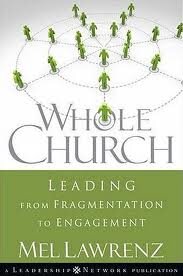Mel Lawrenz, Whole Church: Leading from Fragmentation to Engagement. Jossey-Bass / Leadership Network. Jossey-Bass, 2009.
Referenced in: Strategies for Church Renewal – Integrated Spiritual/Strategic
LifeandLeadership.com Summary
This is a guide for churches to become completely integrated toward God’s vision in all it does, rather than a fragmented collection of vaguely acquainted individuals isolated into ministry silos that do a flurry of unconnected religious activities while behaving in ways that may be mean-spirited, small-minded, self-righteous, and spirit-smothering. Unfortunately, this describes most churches. Over against this is God’s shalom that seeks to tie all of life into a meaningful whole by the transforming presence, power, and mission of God. Lawrenz is motivated by this shalom. He says:
A Whole Church is a local congregation believing that it is called to the whole purpose of God in and through the church, rather than to some specialization. A Whole Church means leading people in practical ways into a true engagement with God (in worship and devotion), engagement with God”s people (in true koinonia), engagement with the community (deployed witness), and engagement with the world (making real connections across national lines). And when we commit to all levels of engagement, we see a truly integrated picture of ministry and church life: worship leads to mission, community enhances personal devotion, witness leads us back to worship again. We see spiritual life with forward momentum as being the great cohesive dynamic of life. We see the gears of the church coming together, fully engaged, and then the engine of God”s power moving the church forward.
Wholeness is our best defense against arbitrary personal ambition and against party spirit in a congregation. A vision of the Whole Church is the big idea that elevates us above our squabbles and our small-mindedness. In those seasons when a sense of Whole Church is the spirit of the majority of a congregation, we see celebration come naturally, and a congregation can come through even the kind of crises that are like earthquakes that shift the ground on which people stand. (5-6)
Most ministers deeply long for this. It is a kind of “unity,” or what Lawrenz calls “cohesion,” but not in the strictly organizational or relational sense we often think of. It is unity with God, with one another, with the world, in a way that God reveals himself through us in ways that he cannot when we are fragmented and distracted. This book has a certain appeal to it that most leaders can relate to. It is not a comprehensive guide. It is more of a call, a vision, and idea generator than a workbook.
If the vision appeals to you, perhaps the best way to use the book is to read and consider whether it would be good for your leadership team to read together. It contains more than 325 concrete ideas for building cohesion (25 at the end of each chapter).
From the Publisher
“I am sick of fragmentation. How about you? The one community that should understand wholeness—and explore it, embrace it, luxuriate in it, model it, enhance it, promote it—is the church.” —Mel Lawrenz
In this timely book Mel Lawrenz—pastor of one of the most innovative churches in America—outlines his proven model for “whole church/whole ministry.” Church leaders and congregants can embrace this model to reinvigorate their mission by engaging with God, each other, their community, and the world. A “whole church” means that a local congregation believes it is called to the whole purpose of God in and through the church, rather than some narrowly defined specialization.
As Lawrenz explains, all too often the church talks about God’s great provisions (grace, salvation, mercy), but they are not applied in real and practical ways in people’s lives. As a result many Christians have become disengaged. Step by step, Lawrenz shows how to apply the four types of engagement that will integrate a church:
- Engage with God—expand the life of worship and personal devotion
- Engage with God’s people—through small groups and other means
- Engage with your community—become involved in meeting social needs
- Engage with the world—develop an awareness and involvement in global mission
The dynamic whole church model is not merely a list of functions or stages of growth. It offers practical, down-to-earth ways to connect the church to its true mission and purpose.
About the Author
Mel Lawrenz is senior pastor at Elmbrook Church in Brookfield, Wisconsin. His Internet ministry, The Brook (www.ComeToTheBrook.org), offers text, audio, and video content to a general audience and to church leaders. Lawrenz is also the host of a weekly regional radio interview program, Faith Conversations, and is the author of several books.
***For additional information on this resource, including reviews, click the bookstore links. Check the reference at page top or the links below for resource guides on related topics.***
Related Areas
See Other Resources on Church Leadership and Renewal:
- Church Leadership and Renewal, Index
- Church Leadership, Theological Foundations, Ecclesiology
- Church Leadership, Philosophical Foundations – e.g. Church Growth, Missional, Emergent, and Other Missionally Responsive Trajectories
- Church Leadership, Practical Foundations – Church Dynamics and Research
- Church Leadership, Practical Foundations – Congregational Culture, Church Identity
- Church Leadership, Practical Foundations – Size Dynamics, Size Transitions
- Church Leadership, Practical Foundations – Research and Case Studies on Effective Churches
- Church Leadership, Special Situations – Small Church Development
- Church Leadership, Strategies for Renewal
See Resources on Over 100 Areas of Ministry Leadership:


